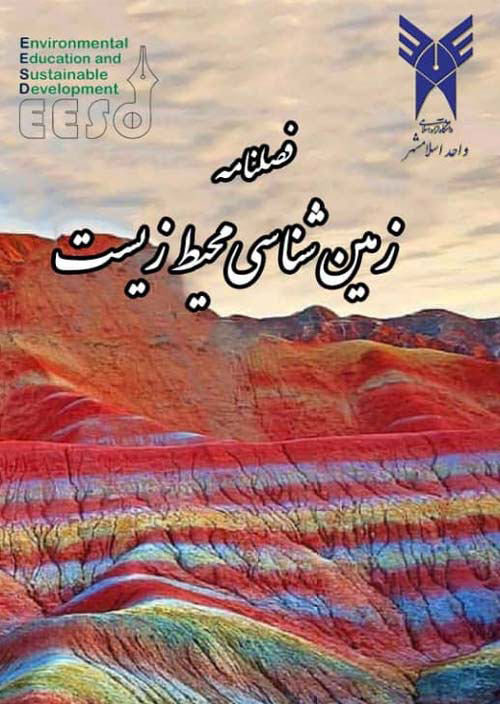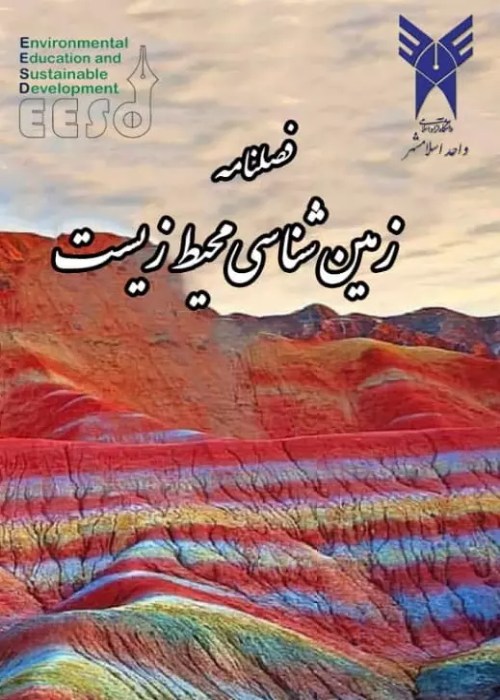فهرست مطالب

نشریه زمین شناسی محیط زیست
پیاپی 55 (تابستان 1400)
- تاریخ انتشار: 1401/05/01
- تعداد عناوین: 4
-
صفحات 1-11
رودخانه قزل اوزن به عنوان یکی از طویل ترین سیستمهای رودخانهای در کشور، به تغییر شکلهای تکتونیکی به خوبی پاسخ داده است. در این مقاله با کشف و توصیف ناهنجاریهای ژیومورفیک در طول رودخانه قزل اوزن و انطباق آنها با خطواره های مغناطیسی، نقش خطواره ها در ایجاد دگرشکلی های فعال مشخص شده است. در این مطالعه ابتدا ناهنجاری های رودخانه ای بر روی تصاویر ماهوارهای شناسایی گردیده و با مدل ارتفاع رقومی و مشاهدات روی زمین تایید شده اند. سپس با خطواره های مغناطیسی استخراج شده از نقشه های مغناطیس هوایی، انطباق داده شده و به این ترتیب چین ها و گسلهای فعال موجود در زیر سطح شناسایی گردیدهاند. اکثر قریب به اتفاق خطواره های مغناطیسی در حوضه رودخانه قزل اوزن موجب ایجاد ناهنجاریهای ژیومورفیک در طول رودخانه شده اند. خطواره های با روند شمال باختری جنوب خاوری ناهنجاری های مختلفی از قبیل تغییر الگوی کانال رودخانه، انحنای مسیر رودخانه و ایجاد نیکپوینت Knickpoint بر روی نیمرخ طولی رودخانه پدید آورده اند. خطواره های با روند شمال خاوری جنوب باختری تنها موجب مستقیم شدگی مسیر رودخانه شده اند.
کلیدواژگان: خطواره های مغناطیسی، رودخانه قزل اوزن، ناهنجاریهای ژئومورفیک، تکتونیک فعال، نیک پوینت -
صفحات 13-26
به علت افزایش شهرنشینی و توسعه جوامع صنعتی، آلودگی در محیط زیست افزایش یافته که فلزات سنگین یکی از آلودگی ها می باشد. رسوبات در یک محیط ساحلی به عنوان یک شاخص و یک مخزن اصلی فلزات سنگین محسوب می شوند. با هدف بررسی میزان آلودگی محیط و موجودات منطقه نمونه های رسوبات سطحی از پنج ترانسکت)گلشهر جنوبی، خواجه عطا، اسکله پشت شهر ، سهراه جهانبار و سورو (در سواحل بندر عباس) شمال شرقی خلیج فارس (در دو فصل گرم و سرد جمع آوری شدند و غلظت فلزات سنگین در آنها اندازه گیری شد. غلظت فلزات سنگین در نمونه ها توسط ICP-MS ارزیابی گردید. آنالیز آماری داده ها با نرم افزار 18.0 SPSS انجام گردید. بالاترین میزان فلز در رسوبات در فصل سرد و فصل گرم در تمامی ترانسکتها متعلق به آهن 1055.53) ± - 9375.25533.00 ± 7862.3(، آلومینیوم 1012.99) ± - 6277.2 479.94 ± (5041 و منگنز 85.26) ± - 738.52 0.94 ± 489.12(گزارش شد. کیفیت رسوبات توسط شاخص آلودگی (CF) تعیین شد. در این مطالعه مقایسه این غلظ ها با استانداردهای جهانی) (USEPA ,1996; ROPME, 2003 انجام گرفت، که میانگین غلظت کادمیوم (Cd) ، آرسنیک (As) ، جیوه (Hg) ، روی (Zn) ، مس (Cu) و سرب (Pb) از استانداردهای جهانی بیشتر بود.
کلیدواژگان: فلزات سنگین، آلودگی، خلیج فارس، رسوبات، Cf -
صفحات 27-45
هدف از این مطالعه، ارزیابی هیدروشیمیایی آب زیرزمینی و تاثیر آن بر کیفیت منابع آب زیرزمینی در منطقه آلوت واقع در شمال باختری ایران به منظور بررسی مطلوب بودن آن برای شرب و آبیاری است. از دیدگاه زمینشناسی، سنگهای دگرگونی از قبیل گنیس، شیست سبز، سریسیت شیست، اسلیت و متاریولیت در بیشتر بخشهای ناحیه آلوت حضور دارند. به منظور ارزیابی هیدروشیمیایی و بررسی کیفیت آب زیرزمینی، از 50 چاه و چشمه موجود در ناحیه مورد مطالعه نمونهبرداری و میزان عناصر سنگین و همچنین پارامترهای مختلف آن اندازهگیری شد. در منطقه مورد مطالعه رخسارههای آب زیرزمینی از نوع بیکربناته کلسیک بوده و برحسب پارامتر سختی کل، عموما دارای آب سخت هستند. برحسب EC و نسبت جذب سدیم (SAR)، درصد سدیم و کربنات سدیم باقیمانده (RSC)، مشخص گردید که آب زیرزمینی در کل برای کشاورزی مناسب است. علاوه بر این، غلظت عناصر سنگین محلول در آب زیرزمینی در منطقه آلوت دارای حدود مجاز تعیین شده توسط سازمان بهداشت جهانی میباشد. استفاده از نسبتهای یونی، نمودار گیبس، شاخص اشباع و آنالیز چند متغیره نشان داد که منابع سیلیکاته دارای بیشترین تاثیر بر شیمی آب در منطقه آلوت هستند. این محاسبات همچنین نشان داد که منبع آب زیرزمینی در ناحیه آلوت عموما از هوازدگی و همچنین از برهمکنشهای آب- سنگهای سیلیکاته منشا گرفتهاند. براساس این مطالعات آبهای زیرزمینی ناحیه آلوت برای شرب، آبیاری و کشاورزی مناسب بوده، از نظر شیمیایی از نوع بیکربناته کلسیک و سخت هستند. مطالعات آماری نشاندهنده نتایج مشابه بین آنالیز فاکتوری و آنالیز خوشهای است.
کلیدواژگان: آب زیرزمینی، هیدورشیمی سختی کل، بی کربناته، آلوت، ایران -
صفحات 47-62
تالاب میقان در استان مرکزی در 15 کیلومتری شمالشرقی اراک و جنوبغربی داوودآباد قرار گرفته است. به منظور تعیین ایستگاههای نمونهبرداری از این تالاب فصلی ابتدا بازدید میدانی صورت گرفت، سپس در قسمتهایی که به نظر میرسید به لحاظ طبیعی و مصنوعی تغییرات در کیفیت آب قابل ملاحظه باشد، 12 نمونه برداشت و پارامترهای کیفی در این نمونهها بررسی شد. با استفاده از دو شاخص NSFWQI و IRWQISC وضعیت کیفی تالاب بررسی شد. همچنین با استفاده از سامانه اطلاعات جغرافیایی، نقشه پهنهبندی پارامترها و شاخصها تهیه گردید. نتایج مقایسه غلظت پارامترهای اندازهگیریشده در فصل تابستان و پاییز نشان داد میانگین غلطت فاکتورهای اکسیژنخواهی بیولوژیکی، اکسیژنخواهی شیمیایی، اکسیژن محلول، هدایت الکتریکی، کلیفرم مدفوعی، آمونیوم، نیترات، فسفات، سختی و اسیدیته در تابستان بیشتر از پاییز بوده است، تنها میانگین کدورت در فصل پاییز بیشتر از فصل تابستان بود. نتایج شاخص کیفیت آب سطحی نشان میدهد که وضعیت ایستگاهها در تابستان و پاییز در وضعیت بد و خیلی بد قرار دارد. نتایج NSFWQI نشان میدهد که به طور کلی وضعیت ایستگاهها در تابستان و پاییز در وضعیت بد و متوسط قرار دارد. نقشه پهنهبندی شاخص NSFWQI در دو فصل تابستان و پاییز نشان داد که تالاب از نظر وضعیت شاخص مذکور در حالت متوسط قرار دارد تنها در محدوده کوچکی نزدیکی ورودی تصفیهخانه وضعیت بد کیفی ثبت گردید.
کلیدواژگان: کیفیت آب، شاخص NSFWQI، IRWQISC، پهنه بندی، تالاب میقان
-
Pages 1-11
The Ghezel Ozan River, the longest river system in the country, has responded to tectonic deformation thoroughly. In this paper the role of lineaments in making of active deformations via detection and characterization of geomorphic anomalies in the Ghezel Ozan River and correlation with magnetic lineaments is specified. In this study, the first fluvial anomalies have been identified on the satellite images and approved through DEM and field observations. Then these anomalies have been correlated with magnetic lineaments extracted from aeromagnetic maps and so the sub-surface active folds and faults have been recognized. Most ofthemagnetic lineaments in the Ghezel Ozan River basin have caused the geomorphic anomalies in the length of the river. The lineaments with trend of NW - SE have created various anomalies such as variations of channel pattern of the river, deflection of the river course and knick points in longitudinal profile of the river. The lineaments with trend of NE - SW have only straightened the course of the river.
Keywords: Magnetic lineaments, Ghezel Ozan River, Geomorphic anomalies, Active tectonics, Knickpoint -
Pages 13-26
Due to increasing urbanization and industrial development, environmental pollution has increased and heavy metals are one of the most groups of pollutant. Sediments act as indicators of heavy metal in coastal environment, they are the main reservoir of heavy metals. Inorder study about environmental pollution and the andemic species, sediments and T. mutabilis samples were collected from 5 transects (South Golshahr, Khaje Ata, Posht-e- shahr, Jahanbar rahe Se, Soro) of the Bandar Abbas (NE Persian Gulf) in cold and warm season, and the metal concentrations were determined for them. Metals contents were analyzed by using ICP-MS. Statistical analysis was performed with SPSS 18.0 software. The highest amount of metals belongs to Fe, Al, Mn in warm and cold season. Sediment quality was measured by Contamination Factor. Cd, As, Hg, Zn, Cu & Pb levels in sediments from all transects higher than the recommended values of standard (USEPA ,1996; ROPME, 2003).
Keywords: Heavy metal, Pollution, Persian Gulf, Sediments, Cf -
Pages 27-45
The main aim of this paper is the hydrochemical evaluation of groundwater and Its impact on the quality of groundwater resources in order to check its suitability for drinking and irrigation In Alut area located in northwestern Iran. Geologically, metamorphism rocks are present in most parts of the Alut area for example Gneiss, Green schist, sericite schist, slate and metaryholite. In order to evaluation of groundwater quality and hydrochemical assesment, samples were taken from 50 wells and springs in the study area and the amount of heavy metals as well as its various parameters were measured. In the studied area, the groundwater facies belong to the calcic bicarbonate type and generally hard water due to the total hardness. In terms of EC and sodium adsorption ratio (SAR), Na% and residual sodium carbonate (RSC), the groundwater is totally suitable for irrigation. Moreover, dissolved heavy elements concentrations in the groundwater of the Alut area have the safe limits which recommended by the WHO. Based on the ionic ratios, Gibbs diagram, saturation index and multivariate analysis indicate that silicate sources had a relatively large impact on water chemistry in the Alut area. These calculations also showed that the groundwater source in the Alut area generally originated from weathering and interactions between silicate water and rock. Based on these studies, ground waters in Alut area are suitable for drinking, irrigation and agriculture and are chemically of a calcium bicarbonate type, and hard. Statistical studies show similar results between factor analysis and cluster analysis.
Keywords: Groundwater, Hydrochemistry, Total hardness, bicarbonate, Alut, Iran -
Pages 47-62
Mighan Lagoon is located in the Central Province, 15 km northeast of Arak and southwest of Dawoodabad. In order to determine the sampling stations of this seasonal wetland, first, it was done in the field, then in the parts where it seems that natural and artificial changes in water quality can be seen, 12 samples were taken and quality points in these samples. became. Using NSFWQI and IRWQISC indicators, the quality status of the lagoon was checked. Also, using the geographic information system, a map of zoning and indicators was prepared. The results of the comparisons measured in summer and autumn showed the errors of biological desirability factors, chemical desirability properties, solution, electrical conductivity, fecal coliform, nitrate, phosphate, hardness, and acidity were more in summer than in autumn. The results of the water surface quality index show that the situation in summer and autumn is in bad and very bad condition. NSFWQI results show that in general the situation in summer and autumn is in bad and moderate condition. NSFWQI index zoning map in the summer and autumn seasons showed that the wetland was recorded in poor quality only in a small area near the entrance of the house.
Keywords: water quality, NSFWQI index, IRWQISC index, zoning, Miqan wetland


